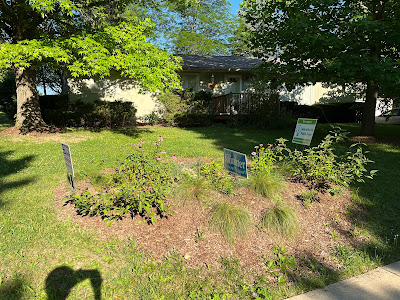Back when I was writing and performing climate theater, it was a very useful exercise to view things like the earth or the economy as characters. Upon reflecting on what sort of character a front lawn might be, I realized that the expanse of mowed grass is much like a trophy wife for the House. Expected to be well manicured, passive and forever young, the front lawn serves no other purpose than to present a flattering view of the House to the public. In return for its submissiveness, the front lawn is allowed, and in fact expected, to remain perpetually idle. Any shift away from bland formality, such as a wildflower meadow or, heaven forbid, a vegetable garden, would be unbecoming and steal attention away from the House. It seemed to me the front lawn could benefit from a good turf therapist who could help her sort through how she ended up in such a one-way relationship, and from that developed a monologue called Turf Therapy.
News from the preserves, parks and backyards of Princeton, NJ. The website aims to acquaint Princetonians with our shared natural heritage and the benefits of restoring native diversity and beauty to the many preserved lands in and around Princeton.
Wednesday, July 27, 2022
The Evolution of the Front Lawn in Ann Arbor, MI
It's easy to knock suburban culture's striving for a sterile deep green conformity, and the chemical dependency and noxious lawn equipment that keeps it propped up. But most homeowners find themselves completely unprepared to own land, and the myriad kinds of plants that grow upon it. No surprise, then, that people try to turn the outdoors into as simple a landscape as possible, essentially an extension of the indoors. A lawn is the equivalent of a wall-to-wall carpet.
While most plantings tend to hug the edges and stick close to the house, in this yard a Salvia is boldly asserting itself right out in the middle of the yard.
Interestingly, some of her bur oaks are getting tall enough to start interfering with the solar panels on their garage. She has started managing her front yard forest, removing larger trees while keeping smaller ones not tall enough to shade the panels. It's a way of having your trees and panels, too. Each tree removed leaves a legacy of roots--a network of carbon consumed from the air and injected into the ground.
Even in more upscale neighborhoods, where homeowners can afford to hire landscapers, many yards are cared for by crews that carefully weed the wildflower meadows, displacing the noisy custodial crews that "mow, blow, and go." What a pleasure to bicycle through a lovely neighborhood with colorful, botanically interesting yards and a delicious quiet. Machines to suppress vegetation are replaced by skilled intervention to steer vegetation. All week in Ann Arbor, the neighborhoods were remarkably quiet. I looked online for information about bans on leaf blowers, and could only find a ban on 2-cycle lawn equipment in the city's downtown, passed in 2019.
Here's an effort to grow sweet potatoes, not only for the tubers but also for the leaves, which are delicious. Fabric is spread on the ground to suppress weeds, and fencing suspended above to deter the deer.
The shift from lawn to meadow in many yards was surely inspired in part by the work of Jeannine Palms, who with her preschool kids, neighbors and town staff have carved native wet meadows into what had been a vast expanse of turfgrass in nearby Buhr Park.
Their meadows have many of the same wildflowers we have in Princeton, with some differences. The photo shows gray-headed coneflower, which is close in appearance to our cutleaf coneflower. And they have additional kinds of Silphium (rosinweed, prairie dock, compass plant), and a grass called smooth cordgrass.
More recently, Jeannine has led a volunteer effort to shift even more of the park away from turfgrass, in this case to create a food forest packed with grapes, apples, pears, elderberry, pawpaw, currants, raspberries, strawberries, fennel, and a "three sisters" planting of corn, beans and squash.
The story of this heroic transformation is told in a sign posted next to the first wet meadows. In the process, they have brought diverse, edible life back to the land and the neighborhood.
Subscribe to:
Post Comments (Atom)











YES! Way on the high side of Positive News! Next step: SH On the Road, documenting our "growing" awareness of Native Plants, Lawns-to-Gardens, Food Forests, etc. all over the country (OR: encouraging local gardeners' groups to do so and send to you for collation into a book?). In general: Really enjoy learning What's Out There from your careful photos (especially being able to magnify them to study up close-er); things I've seen but didn't know names of. My sibs have plant IDs on their smart phones, but I'm an elder, flip-phone type.
ReplyDelete